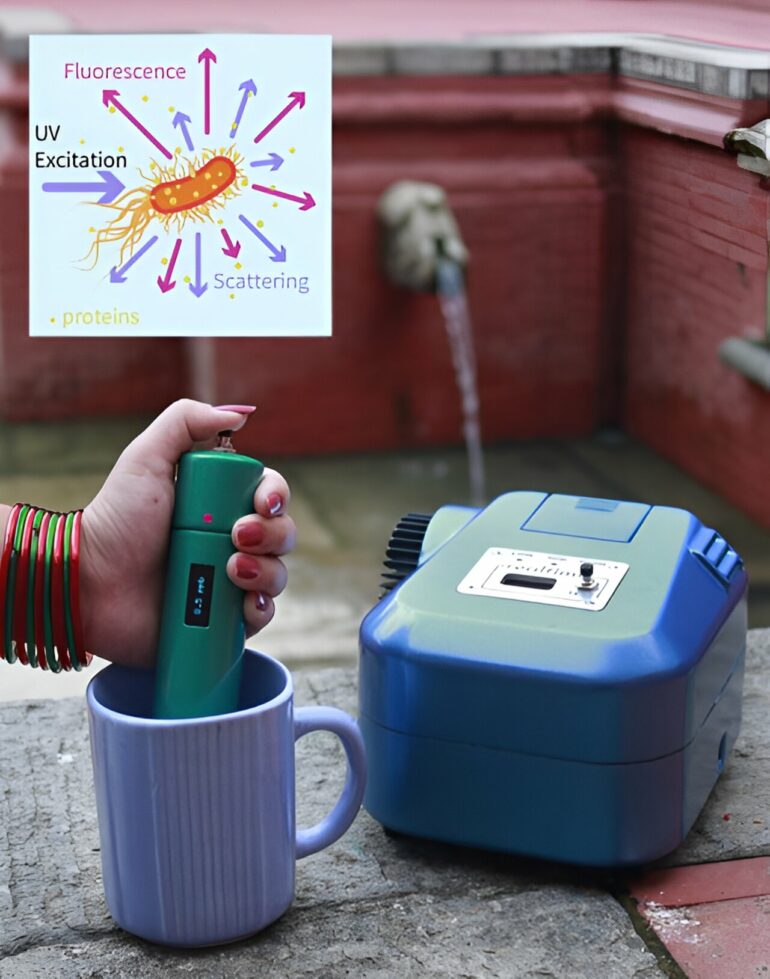Researchers have shown that a fluorescence detection system that doesn’t contain any lenses can provide highly sensitive detection of deadly microorganisms in drinking water. With further development, the new approach could provide a low-cost and easy-to-use way to monitor water quality in resource-limited settings such as developing countries or areas affected by disasters.
It could also be useful when water safety results are needed quickly, such as for swimming events, a concern highlighted during the Paris Olympics.
“In developing countries, unsafe water sources are responsible for more than one million deaths each year,” said research team leader Ashim Dhakal from the Phutung Research Institute in Nepal. “We hope that our work will facilitate the development of simpler and cost-effective yet highly efficient sensing paradigms for drinking water, saving countless lives around the world.”
Current methods used to assess microbial contamination in water require culturing the water samples and then quantifying harmful bacteria. This can take over 18 hours, making it impractical when immediate confirmation of water safety is needed. This is also a key reason why water surveillance is ineffective in developing countries, where the required skilled human resources, infrastructure and reagents are not readily available.
In a paper, “When a lensless fluorometer outperforms a lensed system” published in Optica, researchers from Phutung Research Institute, University of São Paulo in Brazil and University of York in the UK report that their new water monitoring fluorometer can detect fluorescent proteins from bacteria in water down to levels of less than one part per billion, without using any lenses.
This sensitivity meets the World Health Organization’s criteria for detecting fecal contamination in drinking water.
“Today’s fluorometers typically use costly lenses that are made of specialty UV-transparent glass and require precise positioning,” said Dhakal. “We show that eliminating the lenses not only reduces the device cost, size and weight but also provides better performance given that we are not aiming for imaging here.”
Getting rid of the lenses
This research is part of a larger project to pilot a portable, low-cost and user-friendly instrument for real-time water quality assessment. During development, the researchers closely examined the fundamentals of optical signal generation in applications like water quality monitoring.
They discovered that while optical lenses are commonly used in devices such as cameras, microscopes and telescopes, these optical components often reduce performance for practical situations that don’t require images.
“This was an important finding because lenses account for a significant share of the costs of optical systems and their bulk and weight make it difficult to create practical portable devices,” said Dhakal.
“Our analysis revealed that using a light source, detectors and sample sizes that are all as large and as close to each other as possible produces a stronger signal, leading to better performance for water quality monitoring.”
Comparison with a lensed system
Based on their findings, the researchers designed a lensless fluorescence system using large (1–2 mm2) LEDs and detectors, which have recently become available in UV wavelengths. It works by using UV light to excite proteins from harmful microbes and then detecting the resulting fluorescence.
In addition to demonstrating the lensless system’s sensitivity, they also showed that it produced a fluorescence signal that is about double the strength of a lensed system. They found that the performance of the lensed system was limited by its numerical aperture, the use of larger sources and detectors and the finite imaging distance required between the components and the sample.
The researchers are now developing a pocket-sized version of the lensless fluorometers for field testing. They point out that the instrument must be shown to withstand the harsh environments found in multiple scenarios before being widely applied. They are also working to demonstrate that their approach meets the specificity requirements for detecting specific bacterial contamination by incorporating measurement of multiple parameters into the device.
“Our system is already highly useful because the sensitive and accurate measurement of concentration of bacterial proteins that it provides is directly related to efficiency of water treatment, the dose of disinfectants required for disinfection and the likelihood of bacterial proliferation in a recontamination event,” said Dhakal.
More information:
Asim Maharjan et al, Lensless fluorometer outperforms lensed system, Optica (2024). DOI: 10.1364/OPTICA.527289
Citation:
Lens-free fluorescence instrument detects deadly microorganisms in drinking water (2024, August 8)



